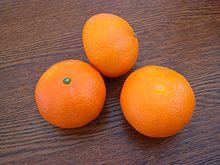| Tangor | |
|---|---|
 | |
| Ortanique | |
| Scientific classification | |
| Kingdom: | |
| (unranked): | Angiosperms |
| (unranked): | |
| (unranked): | |
| Order: | |
| Family: | |
| Genus: | |
| Species: | C. reticulata × sinensis |
| Binomial name | |
| Citrus reticulata × sinensis | |
The tangor (C. reticulata × C. sinensis) is a citrus fruit hybrid of the mandarin orange (Citrus reticulata) and the sweet orange (Citrus sinensis).[1] The name "tangor" is a formation from the "tang" of tangerine and the "or" of "orange". Also called the temple orange, its thick rind is easy to peel and its bright orange pulp is sour-sweet and full-flavoured.[1]
Varieties
Tangors are purposely bred or accidental hybrids of the sweet orange (Citrus sinensis) and the mandarin (Citrus reticulata), producing several varieties.[1]
- 'Clementine' (a commercially important cultivar)
- 'King' ("King of Siam"; formerly Citrus nobilis)
- 'Kuchinotsu No. 37' (Kiyomi x Encore)
- 'Murcott' ("honey Murcott"; "Murcott honey orange"; "red"; "big red")
- 'Ortanique' (originally found in Jamaica, the name comes from the words "orange", "tangerine", and "unique")
- 'Temple' (believed to be the same as the "magnet" variety of Japan)[1]
- 'Umatilla' (misnomer "Umatilla tangelo")
- 'Pontianak' (originally found in Indonesia, named after a provincial capital)
- 'Setoka' (Japan, hybrid of Murcott and Kuchinotsu No.37)
Satsuma tangors
- 'Iyokan' (Miyagawa × unknown sweet orange)
- 'Miyauchi Iyo' (early-ripening Iyo mutant)
- 'Othani Iyo' (late-ripening Miyauchi mutant)
- 'Kiyomi' (Miyagawa × Trovita navel orange)
- 'Seto' (Sugiyama Unshiu × Trovita navel orange)
- 'Reikou' ((Kiyomi x Encore) x (No. 5 x Marcott))
Cultivation regions
Since the 19th and early 20th centuries, the tangor has been cultivated in tropical and warm temperate world regions, such as southern Japan, Florida, Caribbean islands, South Africa, and Malaysia.[1]
Pests and diseases
The 'Ortanique' variety may be attacked by aphids (Aphis gossypii), rust mite (Phyllocoptruta oleivora) or various species of scale insects and moths.[1] The fungus, Sphaeropsis tumefaciens, may cause knots in twigs.[1]
References
External links
- Satsuma hybrids
- Temple tangor by Citrus Variety Collection